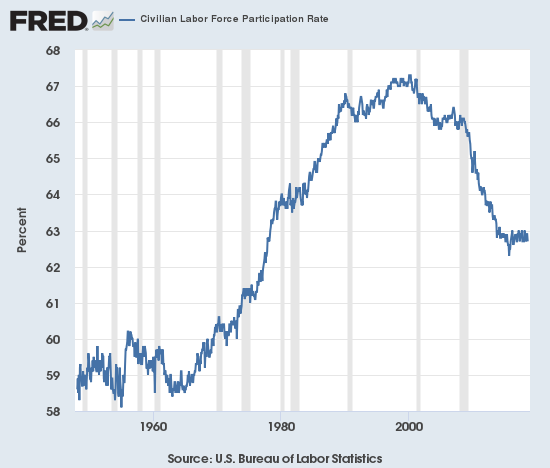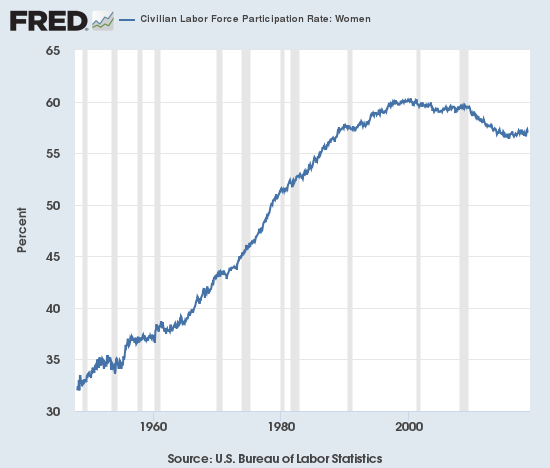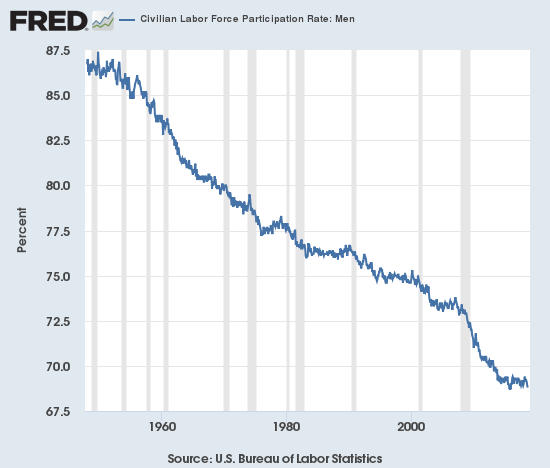Summary:
Few conventional-media commentators are willing or able to discuss these factors in the labor shortage / declining participation trends. Is there a labor shortage in the U.S.? Employers are shouting “yes.” Economists keep looking for wage increases as evidence of a labor shortage, and since wage increases are still relatively modest, the argument that there are severe labor shortages in parts of the U.S. is unpersuasive to many conventional economists. But if we look at “we’re hiring” signs and billboards, it’s clear employers are having trouble filling available positions. Longtime correspondent Harvey D. recently submitted this list of billboards advertising job openings in South Carolina: “Here’s a sample of
Topics:
Charles Hugh Smith considers the following as important: 5) Global Macro, Featured, newsletter, The United States
This could be interesting, too:
Few conventional-media commentators are willing or able to discuss these factors in the labor shortage / declining participation trends. Is there a labor shortage in the U.S.? Employers are shouting “yes.” Economists keep looking for wage increases as evidence of a labor shortage, and since wage increases are still relatively modest, the argument that there are severe labor shortages in parts of the U.S. is unpersuasive to many conventional economists. But if we look at “we’re hiring” signs and billboards, it’s clear employers are having trouble filling available positions. Longtime correspondent Harvey D. recently submitted this list of billboards advertising job openings in South Carolina: “Here’s a sample of
Topics:
Charles Hugh Smith considers the following as important: 5) Global Macro, Featured, newsletter, The United States
This could be interesting, too:
RIA Team writes The Importance of Emergency Funds in Retirement Planning
Nachrichten Ticker - www.finanzen.ch writes Gesetzesvorschlag in Arizona: Wird Bitcoin bald zur Staatsreserve?
Nachrichten Ticker - www.finanzen.ch writes So bewegen sich Bitcoin & Co. heute
Nachrichten Ticker - www.finanzen.ch writes Aktueller Marktbericht zu Bitcoin & Co.
Few conventional-media commentators are willing or able to discuss these factors in the labor shortage / declining participation trends.
Is there a labor shortage in the U.S.? Employers are shouting “yes.” Economists keep looking for wage increases as evidence of a labor shortage, and since wage increases are still relatively modest, the argument that there are severe labor shortages in parts of the U.S. is unpersuasive to many conventional economists.
But if we look at “we’re hiring” signs and billboards, it’s clear employers are having trouble filling available positions. Longtime correspondent Harvey D. recently submitted this list of billboards advertising job openings in South Carolina:
“Here’s a sample of billboards in upstate South Carolina, a heavily industrialized area along I-85:
Michelin – $16.50 & up to start, depending on experience.
BMW – $18.50 & up (not to mention that they’re going to build the 23,000 Amazon delivery vans there.)
MAU (staffing firm) – $18.50 & up for forklift operators; they have 3,000+ students in industrial skill training courses in GA/SC/NC/AL
DHL (staffing) – need forklift & general machinists, $20 & benefits
Greenville Tech (vo-tech school) – recruiting students for master welding classes, you can make $80K w/ 5 yrs experience.
Even Chick-Fil-A is offering $13 w/ bennies for full/part-time if you can pass a drug test and are 18+…
every trucking firm & almost every business has a banner in their front yard saying “WE’RE HIRING”.
There are numerous theories about the causes of labor shortages and the lack of wage pressure. One reality Harvey described in his email is the difficulty small businesses have in raising wages as 1) the cost of benefits such as healthcare insurance skyrocket, pushing total compensation costs higher even if the wages employees see remain the same and 2) the difficulty in passing on higher labor costs.
Few small businesses are monopolies; if prices move up, customers go elsewhere or put off the purchase. Even corporations’ ability to raise prices without losing sales is limited, hence the popularity of reducing quantity (the ever-shrinking serving size) or quality (appliances with inferior components that fail in a few years, etc.)
|
Let’s look at the labor participation rates for the populace at large, women and men. The labor participation rate reflects the percentage of the population that’s in the workforce, either working or actively looking for work.
That the number of people in the workforce has declined significantly is well-known. The US Census pegs the number of people ‘not in the labor force’ at 95 million.This includes people who are disabled, in school, etc., so the number should be taken with a grain of salt. But the decline in the relative size of the labor force is stunning:
|
Civilian Labor Force Participation Rate 1960-2000 |
| Interestingly, the labor participation rate for women has held steady compared to the entire populace. |
Civilian Labor Force Participation Rate: Women 1960-2000 |
| Now compare it to the labor participation rate for men, which has absolutely cratered: |
Civilian Labor Force Participation Rate: Men 1960-2000 |
Labor Force Statistics from the Current Population Survey (Bureau of Labor Statistics)
It’s hard to find statistics for many of the dynamics behind the sharp decline of male participation in the official workforce, as few institutions track such trends such as the number of men making a living in the black market. It’s hard to estimate this number and hard to get those engaged in the black market to answer honestly to questions about activities that break laws requiring the reporting of all income, regardless of source.
Despite the lack of statistics, we can assemble some anecdotal factors:
1. Failing the standard employment drug test. Should marijuana use bar all employment? Employers are beginning to question this Drug Gulag Inquisition assumption. Anecdotally, up to 70% of all applicants fail these drug tests.
2. Felony conviction for non-violent (i.e. drug-related) crime. Once again, Employers are beginning to question this Drug Gulag Inquisition assumption, as felony convictions are excluding millions of otherwise employable people from the conventional job market.
3. Pay not worth the trouble. As difficult as this might be for many to accept, a job paying X dollars per hour can be viewed as not worth the trouble if the commuting costs are high, the cost of living near the job is higher, and some other source of lower but still adequate income is available: disability, parents, girlfriend, dealing drugs, working informally for cash, the gig economy, etc.
4. Informal / black-market income. $15 per hour after deductions equals $11 per hour, while $15 in cash is still $15. Over the course of a year, that’s the difference between $30,000 and $22,000. That $8,000 represents a 36% “raise.”
5. Misplaced sense of pride / dignity. Many tradecraft jobs (welding, construction, etc.) have traditionally provided male workers with strong identities and sources of pride and dignity. That even these jobs are going begging suggests the possibility that at least some males no longer gain the pride / dignity they desire from work, or they’ve surrendered the desire for earning pride / dignity in the workplace: work is for chumps,etc.
This also suggests that some percentage of the male workforce no longer feels the same need as females do to take jobs in the formal economy regardless of the costs and indignities that go with the territory of commoditized work / employment. In other words, opting out of formal employment appears to be much less of an option for women than for men.
Few conventional-media commentators are willing or able to discuss these cultural / financial factors in the labor shortage / declining participation trends. As with so much of American life, the inconvenient realities may upset somebody, so better to stick with magical-thinking or politically-correct truisms that are completely out of touch with reality but oh-so-acceptable to the status quo.
Maybe it’s time for a real discussion of work and employment in a system dominated by mobile capital and self-serving insiders.
My new book is The Adventures of the Consulting Philosopher: The Disappearance of Drake. For more, please visit the book's website.
Tags: Featured,newsletter




